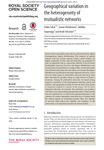Geographical variation in the heterogeneity of mutualistic networks
| dc.contributor.author | Sakai, Shoko | en_US |
| dc.contributor.author | Metelmann, Soeren | en_US |
| dc.contributor.author | Toquenaga, Yukihiko | en_US |
| dc.date.accessioned | 2016-10-11T05:37:30Z | |
| dc.date.available | 2016-10-11T05:37:30Z | |
| dc.date.issued | 2016 | en_US |
| dc.identifier.other | HPU4160705 | en_US |
| dc.identifier.uri | https://lib.hpu.edu.vn/handle/123456789/23599 | |
| dc.description.abstract | Plant–animal mutualistic networks are characterized by highly heterogeneous degree distributions. The majority of species interact with few partner species, while a small number are highly connected to form network hubs that are proposed to play an important role in community stability. It has not been investigated, however, if or how the degree distributions vary among types of mutualisms or communities, or between plants and animals in the same network. Here, we evaluate the degree distributions of pollination and seed-dispersal networks, which are two major types of mutualistic networks that have often been discussed in parallel, using an index based on Pielou’s evenness. | en_US |
| dc.format.extent | 10 p. | en_US |
| dc.format.mimetype | application/pdf | |
| dc.language.iso | en | en_US |
| dc.subject | Biology | en_US |
| dc.subject | Ecology | en_US |
| dc.subject | Evolution | en_US |
| dc.subject | Pollination | en_US |
| dc.subject | Seed dispersal | en_US |
| dc.subject | Ecological network | en_US |
| dc.subject | Degree distribution | en_US |
| dc.subject | Specialization | en_US |
| dc.subject | Network heterogeneity | en_US |
| dc.title | Geographical variation in the heterogeneity of mutualistic networks | en_US |
| dc.type | Article | en_US |
| dc.size | 503KB | en_US |
| dc.department | Education | en_US |
Files in this item
This item appears in the following Collection(s)
-
Education [806]

